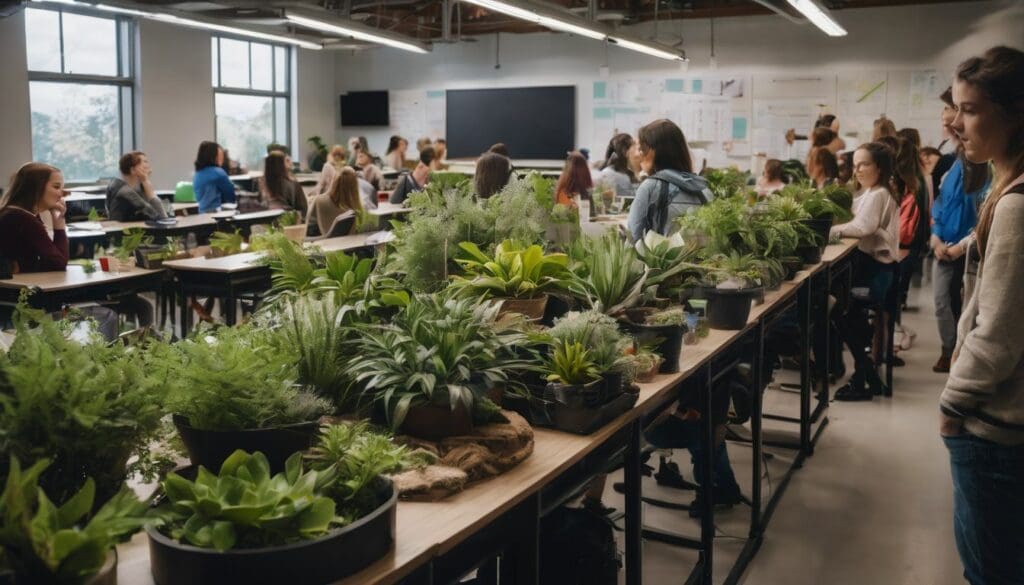It’s a myth that greenery in the classroom is just for show; in truth, it’s a powerful tool shaping our future. As an expert with years spent exploring sustainable education and its impact on young minds, I’ve seen first-hand how green schools are revolutionising learning.
These innovative spaces blend environmental stewardship with academic excellence, creating classrooms where sustainability isn’t an afterthought—it’s the foundation.
Did you know greener schools can help reduce energy use by up to one-third? It turns out that when we invest in eco-friendly learning environments, we’re not only nurturing the planet but also cultivating healthier and more focused students.
The insights ahead might just inspire your next step towards educational change. Read on—you may be surprised!
Key Takeaways
- Green schools incorporate environmental, social, and cultural awareness into their education system. They engage students in projects that combine environmental issues with local traditions to develop a deep understanding of sustainability across different societies.
- These sustainable schools operate eco-friendly by using renewable energy sources like solar panels, reducing greenhouse gas emissions with energy-efficient technologies, and implementing waste reduction programs, making them less harmful to the planet.
- Outdoor classrooms and green roofs are examples of how green schools integrate nature into learning spaces. This not only creates an aesthetically pleasing environment but also serves as practical tools for teaching about biodiversity and ecological stewardship.
- Government policies support sustainable schools through grants, funding for green infrastructure, inclusion of environmental education in curricula, incentives for clean energy use, community engagement programs focused on conservation efforts.
- While maintaining eco-friendly practices requires consistent funding and community involvement which can be challenging for sustainable schools, they have opportunities to educate future generations on responsible environmental stewardship through hands-on experience and real-world applications of conservation principles.
Philosophy and Methodology of Green Schools
Green schools integrate environmental, social, and cultural awareness into education while promoting hands-on learning and community engagement. They encourage sustainability as a central learning axis, providing a holistic approach to education.
Integrating environmental, social, and cultural awareness into education
Teachers are weaving the environment, society, and culture into lessons to create a comprehensive understanding of our world. This approach encourages students to think critically about their role in society and the impact of their actions on the planet.
Schools craft projects that tackle environmental issues while honouring local traditions and social norms. By doing this, they help young minds appreciate diversity and realise that sustainable living varies across cultures.
Classroom discussions often revolve around how societies can grow without harming natural habitats or depleting resources. Students learn to connect environmental conservation with cultural respect by studying different community responses to climate change.
They participate in planting gardens that nurture biodiversity, providing them with hands-on experience in creating eco-friendly environments. These educational strategies lay a foundation for future leaders who understand the importance of balancing ecological preservation with societal needs and cultural values.
Promoting hands-on learning and community engagement
Integrating environmental, social, and cultural awareness into education fosters a natural segue into promoting hands-on learning and community engagement. Sustainable schools actively involve students in practical activities that promote eco-friendly practices, such as gardening, composting, and energy conservation.
This approach not only enhances their understanding of sustainability but also instils a sense of responsibility towards the environment. Additionally, sustainable schools engage with local communities through outreach programs, creating partnerships for conservation initiatives in the surrounding areas.
Encouraging active participation and fostering connections within the community helps students understand the real-world impact of ecological choices while nurturing a sense of stewardship towards nature.
Encouraging sustainability as a central learning axis
Green schools place a strong emphasis on integrating sustainability into their curriculum, aiming to instil environmental awareness and eco-friendly practices in students. By incorporating hands-on, inquiry-based instruction and promoting green infrastructure, sustainable schools foster an understanding of the importance of conservation education in academic performance.
Furthermore, these eco-friendly schools provide healthy and conducive learning environments by maximising natural daylight and views to the outdoors, contributing to the overall well-being of students.
Schools that focus on sustainability not only teach about it but also actively involve students in discussions and decisions related to campus sustainability. By doing so, they nurture environmental stewardship while providing educational opportunities for students to engage with real-world issues such as energy conservation and climate change.
Through this approach, green schools play a vital role in transforming education towards sustainable development goals and greening education partnerships.
Benefits of Sustainable Schools
Sustainable schools offer reduced environmental impact, improved physical and mental health, durability and adaptability, aesthetically pleasing spaces, and educational and demonstration value.
These benefits contribute to a holistic approach to education that fosters sustainability and encourages students to become environmentally conscious citizens.
Reduced environmental impact
Green schools significantly reduce environmental impact through sustainable practices and eco-friendly operations. Utilising renewable energy sources, such as solar panels and wind turbines, schools minimise their carbon footprint while demonstrating the benefits of clean energy to students.
Implementing energy-efficient technologies and eco-friendly infrastructure designs also contributes to reduced greenhouse gas emissions and overall resource conservation. Additionally, sustainable schools prioritise waste reduction, recycling programmes, and water conservation measures to further lessen their environmental impact, providing real-world examples of sustainable practices in action.
Furthermore, green schools promote eco-friendly transportation options like cycling or walking to school, reducing air pollution and traffic congestion. By incorporating these initiatives into their daily operations, sustainability education becomes a lived experience for students, empowering them with practical knowledge about preserving the environment.
Improved physical and mental health
Green schools contribute to improved physical and mental health, providing a conducive environment for students to thrive. With 33% less energy usage and 32% fewer greenhouse gases, these schools promote cleaner air and healthier surroundings.
Natural daylight and outdoor views in sustainable school buildings enhance student well-being, supporting a positive learning experience. Involving students in eco-friendly practices fosters their connection to nature, promoting mindfulness and mental well-being.
Furthermore, sustainability education encourages active participation in environmental conservation activities, which contributes to a sense of purpose and fulfillment among students.
These environmentally conscious initiatives positively influence the overall health of the school community by reducing exposure to harmful toxins while fostering an appreciation for eco-friendly living.
Durability and adaptability
Sustainable schools prioritise durability and adaptability in their structures, aiming to reduce maintenance costs and create long-lasting facilities that can withstand environmental challenges.
These buildings are designed with eco-friendly materials, energy-efficient systems, and resilient construction techniques to ensure they can endure the test of time. Emphasising low-impact development strategies, sustainable schools integrate adaptable designs that allow for future expansions or modifications, aligning with the principles of ecological conservation.
Additionally, sustainable schools focus on adaptability by incorporating flexible spaces that can evolve to meet changing educational needs while promoting a healthier environment for students and staff members.
Aesthetically pleasing spaces
Green schools create aesthetically pleasing spaces that inspire and engage students. Natural daylight, greenery, and sustainable design elements contribute to a visually appealing environment.
According to the UK Environmental Protection Agency (EPA), these well-designed spaces enhance student well-being, improve concentration levels, and promote a sense of calm. Incorporating nature into educational settings also supports hands-on learning opportunities about environmental sustainability, reinforcing classroom teachings with real-world examples.
Furthermore, sustainable school models prioritise creating beautiful outdoor landscapes that not only add aesthetic value but also serve as living laboratories for ecological lessons.
Educational and demonstration value
Moving on from creating aesthetically pleasing spaces, sustainable schools also hold significant educational and demonstration value. By integrating environmental issues into the curriculum and involving students in hands-on, inquiry-based instruction, green schools provide a unique opportunity for children to learn about eco-friendly practices and sustainability.
In addition to reducing energy consumption and greenhouse gas emissions by a substantial percentage, sustainable schools serve as living examples of how environmentally conscious choices can positively impact our surroundings.
Through promoting natural daylight and views to the outdoors, these schools create an environment that supports physical health and mental well-being while teaching young minds the importance of conservation.
How Sustainable Schools are Achieving Green Goals
Sustainable schools achieve green goals through sustainable architecture and design, integrating eco-friendly practices into the curriculum, promoting green infrastructure, and fostering environmental stewardship among students.
These efforts contribute to reducing the environmental impact of schools and creating aesthetically pleasing, educational spaces.
Sustainable architecture and design
Green schools prioritise sustainable architecture and design to create eco-friendly spaces that minimise environmental impact while promoting a healthy and inspiring environment for students.
Buildings are constructed to reduce energy consumption, with features like natural daylighting, efficient insulation, and renewable energy sources. This not only lowers operating costs but also provides real-world examples of sustainability in action.
Moreover, green schools incorporate environmentally friendly materials, water-saving systems, and innovative designs that encourage ecological awareness among students. These measures align with the push for climate change education within school curricula and help promote a culture of sustainability from an early age.
The design of sustainable schools goes beyond infrastructure; it encompasses a holistic approach that integrates nature into the built environment. For instance, outdoor classrooms, green roofs, and rain gardens serve as hands-on learning tools for teaching about biodiversity conservation and environmental stewardship.
Integration of sustainable curriculum
Schools are integrating sustainable practices into their curriculum, educating students about environmental issues, energy conservation, and eco-friendly practices. This approach aims to instill a sense of responsibility and stewardship for the environment in students from an early age.
By promoting hands-on, inquiry-based instruction and incorporating green curriculum, schools play a crucial role in fostering knowledge and skills for sustainable development among future generations.
Through this integration, students gain practical experience in addressing ecological challenges and understanding the importance of sustainability.
Sustainable curriculum also supports the overall goals of green schools by reinforcing the connection between education and environmental conservation. It encourages critical thinking about ecological issues while promoting awareness of environmentally friendly practices within school communities.
Promoting green infrastructure
Sustainable schools promote green infrastructure to minimise environmental impact. They incorporate eco-friendly elements such as energy-efficient lighting, rainwater harvesting systems, and green roofs.
These initiatives not only reduce the carbon footprint but also serve as educational tools, demonstrating sustainability in action. Green infrastructure in schools provides a tangible example of environmental responsibility and encourages students to adopt eco-friendly practices.
Educating about sustainable practices extends beyond the classroom into the school’s physical environment. Schools integrate features like renewable energy sources and waste reduction systems to create a more sustainable campus.
Fostering environmental stewardship
Green schools actively engage students in environmentally friendly practices. They encourage hands-on, inquiry-based learning to nurture a sense of responsibility and care for the environment among students.
Green schools teach energy conservation and eco-friendly habits, fostering a culture of sustainability through practical activities. According to the UK Environmental Protection Agency (EPA), sustainable schools play a crucial role in promoting environmental stewardship by educating young minds about the importance of conserving natural resources and minimising waste.
The concept of fostering environmental stewardship is embedded within green school initiatives. By integrating sustainable practices into their infrastructure and curriculum, these schools actively promote eco-friendly behaviours among students and staff alike.
Support for Sustainable Schools
Government policies and initiatives play a crucial role in supporting sustainable schools, while corporate sponsorship and partnerships can also provide valuable resources and expertise to further promote eco-friendly education.
Government policies and initiatives
- Implementation of energy efficiency standards for school buildings, reducing energy consumption and promoting environmental sustainability.
- Provision of grants and funding opportunities to support the development of green infrastructure and sustainable facilities in schools, contributing to reduced environmental impact.
- Integration of environmental education into national curricula, ensuring that students are exposed to knowledge about energy conservation, ecological practices, and sustainability.
- Incentives for schools to adopt renewable energy sources, such as solar panels or wind turbines, promoting clean energy use within educational institutions.
- Support for community engagement programmes that encourage student involvement in local environmental projects, fostering stewardship and raising awareness about ecological issues.
- Recognition and accreditation programmes for schools that demonstrate exceptional efforts in promoting sustainability education, acknowledging their commitment to environmentally friendly practices.
- Collaboration with educational institutions to develop best practices for green schools, sharing resources and expertise to further advance sustainability initiatives within the education sector.
- Advocacy for policies that prioritise eco – friendly procurement practices within school systems, promoting the use of sustainable materials and resources in educational facilities.
Corporate sponsorship and partnerships
Green schools benefit greatly from corporate sponsorship and partnerships, which enable them to implement sustainable initiatives.
- Companies often provide financial support for eco-friendly projects, such as solar panel installations and energy-efficient systems, helping schools reduce their environmental impact and operating costs.
- Partnerships with environmentally conscious organisations allow schools to develop educational programmes focused on conservation and environmental awareness, fostering a culture of sustainability within the student body.
- Corporate sponsors can also contribute expertise and resources towards implementing green infrastructure, such as water conservation systems and waste reduction strategies, promoting eco-friendly practices within the school community.
Challenges and Opportunities for Sustainable Schools
Sustainable schools face challenges in maintaining and funding eco-friendly practices, as well as encouraging community involvement and support. However, they also have opportunities to educate and inspire students, create innovative partnerships, and lead by example in promoting environmental stewardship.
Maintaining and funding eco-friendly practices
Green schools require ongoing support and funding to maintain their eco-friendly practices. This includes investing in sustainable building materials and energy-efficient technologies, as well as implementing recycling programmes and waste reduction strategies.
Government policies that provide financial incentives for green initiatives can help schools to fund these eco-friendly practices, while corporate sponsorship and partnerships with environmentally conscious organisations can also play a crucial role in ensuring the sustainability of green schools.
Educational facilities need sustained commitment from the community to continue their efforts towards environmental conservation. Initiatives such as energy conservation programmes, adoption of renewable energy sources, and implementation of environmentally friendly transportation solutions are key aspects that ensure the long-term success of eco-friendly practices within school environments.
Encouraging community involvement and support
Maintaining and funding eco-friendly practices lays a crucial foundation, but the active involvement of the community is equally essential for sustainable schools to thrive. Engaging local businesses, parents, and community members in green initiatives can enhance environmental awareness and support within the school setting.
By involving the community in eco-friendly projects, such as recycling drives or energy conservation campaigns, green schools can foster a sense of shared responsibility for sustainability while imparting valuable lessons about environmental stewardship.
This collaborative approach not only benefits the school but also creates a ripple effect, inspiring wider ecological consciousness within the local area.
Promoting community involvement in sustainable schools empowers individuals to actively contribute towards creating an environmentally friendly space that promotes holistic education.
Encouraging partnerships with local organisations not only fosters a sense of ownership over eco-friendly endeavours but also provides valuable resources and expertise that enriches sustainability education.
Conclusion
In conclusion, embracing sustainability in education paves the way for a brighter future. Sustainable schools imbue students with crucial environmental consciousness. They also promote healthy and eco-friendly choices within their communities.
As we continue to support green schools, we ensure that the next generation is equipped to lead the charge towards a more sustainable world.
FAQs
1. What are green schools?
Green schools focus on creating an eco-friendly environment and use hands-on, enquiry-based instruction to educate students about sustainable living and environmental issues.
2. How do green schools teach sustainability?
Through engaging activities and lessons that promote energy conservation, these schools offer practical, hands-on learning experiences in sustainable learning.
3. Why is it important for children to learn about environmental issues in school?
It prepares them to understand and address global challenges such as climate change, helping them grow up as responsible citizens who can make eco-friendly choices.
4. Can traditional schools become eco-friendly?
Absolutely! Any school can adopt energy conservation measures and embrace enquiry-based instruction methods to foster a more environmentally conscious mindset among students.





